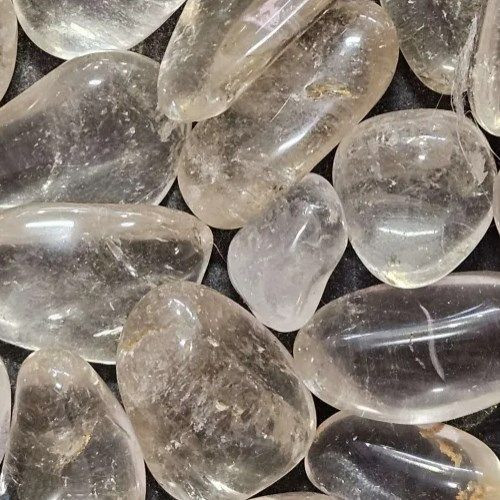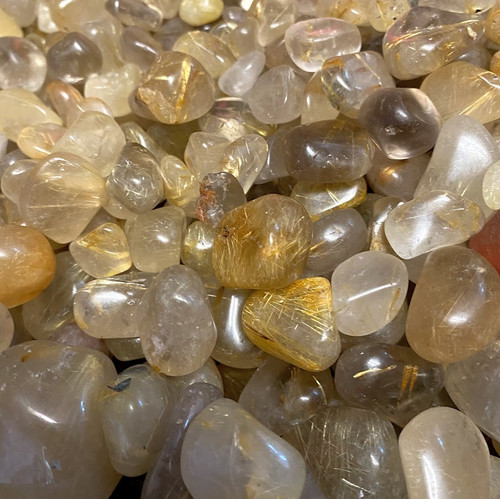Product Description
Quartz Yellow Tumbled Stone 1"
Mineral Information:
Yellow quartz, also known as yellow quartzite or lemon quartz, is a variety of quartz that exhibits a vibrant yellow color. It is valued for its sunny and cheerful hue, which makes it a popular choice for jewelry and decorative purposes. Here are some key features and properties of yellow quartz:
Color: Yellow quartz has a distinct yellow color that can range from pale yellow to intense golden shades. The color is often uniform throughout the crystal or gemstone.
Composition: Yellow quartz is composed primarily of silicon dioxide (SiO₂), the same chemical composition as other varieties of quartz. The yellow color is believed to result from traces of iron impurities within the quartz structure.
Transparency: Yellow quartz can be transparent to translucent, depending on the specimen. Transparent yellow quartz is highly valued for its gemstone quality, while translucent varieties are often used in ornamental and decorative objects.
Hardness: Yellow quartz has a hardness of 7 on the Mohs scale, which means it is relatively durable and resistant to scratching. It is one of the harder gemstone materials and can withstand normal wear and tear.
Luster: Yellow quartz typically has a vitreous or glassy luster when polished, giving it a shiny and reflective appearance.
Origin: Yellow quartz is found in various locations around the world, including Brazil, Uruguay, Madagascar, and Russia, among others. These regions are known for producing high-quality yellow quartz specimens.
Uses: Yellow quartz is widely used in jewelry, including rings, pendants, earrings, and bracelets. Its vibrant yellow color adds a cheerful and radiant touch to jewelry designs. Yellow quartz is also used in decorative objects, such as figurines, carvings, and polished stones for display or spiritual purposes.
Metaphysical Meaning:
Yellow Quartz is associated with warmth, vitality, and optimism. Yellow quartz is thought to bring positive energy, uplift the spirit, and enhance personal power and confidence. It is also believed to stimulate the solar plexus chakra, promoting self-expression, creativity, and mental clarity.
Mineral Care:
Yellow quartz, like other varieties of quartz, is generally considered to be a relatively durable and tough gemstone. However, it is not entirely immune to damage, and some factors can affect its fragility. Here are a few considerations regarding the fragility of yellow quartz:
-
Hardness: Yellow quartz has a hardness of 7 on the Mohs scale, which means it is quite hard and can withstand normal wear and tear. Its hardness makes it resistant to scratching by most common objects. However, it is important to note that even though yellow quartz is relatively hard, it can still be scratched by materials with a higher hardness, such as corundum (including sapphires and rubies) or diamond. Therefore, it is best to avoid contact with harder substances to prevent scratches.
-
Cleavage and Fracture: Quartz, including yellow quartz, does not exhibit cleavage, which refers to the tendency of a mineral to break along planes of weakness. Instead, quartz has a conchoidal fracture, meaning it breaks with smooth, curved surfaces similar to the shape of a shell. This fracture type is generally more resistant to breakage than minerals with prominent cleavage planes. However, it is still possible for yellow quartz to fracture or chip if subjected to significant impact or pressure, particularly if there are pre-existing internal flaws or structural weaknesses.
-
Heat Sensitivity: While yellow quartz is generally heat resistant, extreme temperature changes can potentially cause thermal shock and lead to cracking or breakage. It is advisable to avoid exposing yellow quartz to sudden or drastic temperature variations, such as immersing it in cold water after exposure to high heat. Allow the gemstone to cool or warm up gradually to minimize the risk of thermal stress.
-
Chemical Sensitivity: Yellow quartz is generally resistant to most household chemicals and does not easily react or dissolve in them. However, it is still recommended to avoid exposing yellow quartz to harsh chemicals, strong acids, or abrasive cleaning agents. Prolonged exposure to chemicals may damage the surface or alter its appearance.
In general, yellow quartz is a relatively durable gemstone that can withstand regular wear and handling. However, to maintain its beauty and integrity, it is advisable to handle it with care, avoid contact with harder materials, and store it separately from other gemstones or jewelry items to prevent scratching or potential damage.
Disclaimer:
No information here is intended to diagnose, treat or cure ailments or afflictions of any kind. One should always consult a medical professional if a serious issue presents itself.











